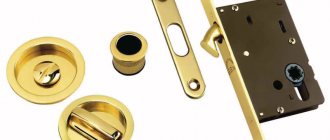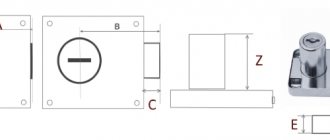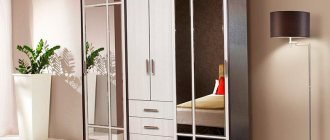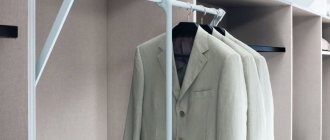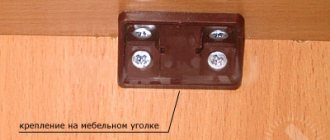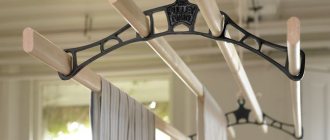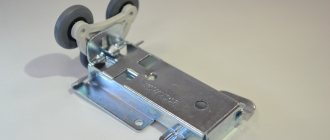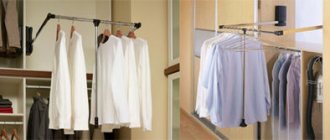Locking devices for drawers
First of all, let's turn our attention to the simplest options for locking drawer cabinets using special latches. The price of the issue is one and a half to two hundred rubles and five minutes of time spent on installing the latches
Such locking devices are very common and can be purchased at almost any store that sells children's goods. There are many names for such devices, for example canpol babies or drawer safety lock.
Such latches are made of plastic and glued to furniture using special reliable Velcro. Over time, they can be carefully torn off, without leaving any traces of glue. The latch consists of two elements, the main device and a plastic counterpart. The device is attached to the edge of the drawer with an overlap on its edge, and the counter part is glued to the body of the piece of furniture. When closing the drawer, you snap it tightly; to open it, you need to simultaneously press two small ears that are located on the body of the device.
A slightly more expensive and complicated, but even more effective way to lock a drawer is to use a handle with a built-in lock. The complexity of this method lies in the need to select a suitable handle so that it fits in place of the piece of furniture you are dismantling. Having bought a new handle, you simply screw it in place of the old one and lock the drawer.
How to lock a wardrobe from children?
Sliding wardrobes with mirrors are very attractive objects for small children. They are drawn to kiss the mirror, roll doors back and forth and pull out things standing on the lower shelves. Under these conditions, you will think about the need for child protection on the wardrobe. After all, pinched fingers and broken doors are the most innocent troubles that can arise as a result of a child’s acquaintance with such furniture.
You cannot install a classic lock on the door leaf of a sliding wardrobe, since it has a completely different opening principle. But this does not mean at all that there are no ways to reliably protect the closet from the attacks of a naughty child. There are two reliable ways to lock a wardrobe: the first method involves using a multi-purpose latch, and the second is using a special lock designed for such furniture.
The multi-purpose latch consists of three plastic parts connected by a special cable. One plastic part is firmly attached with glue to the door leaf of the wardrobe, and the other, called the retainer, hangs freely on a cable. If there is a need to lock the door, you just need to insert the lock into the counterpart attached to the cabinet body, and the opening is carried out with a special secret button.
A specialized fastener for sliding wardrobes has even greater advantages, since it does not need to be glued to the door leaf. It is attached with a latch directly to the handle. To lock the door, you just need to close it all the way, and the latch will come into contact with the cabinet body and block the door leaf. Opening is carried out by pressing a secret button “on the body” of the latch.
To summarize, we note that child protection on drawers and cabinets is not a manifestation of suspiciousness, but a severe necessity. After all, any closet or drawer can easily injure a child. Not to mention the dangerous things that such furniture can hide. Therefore, take care of your children in advance, especially since thanks to modern technology this requires minimal effort.
Protection for wardrobes
Typically, the sliding door of sliding wardrobes is equipped with a large mirror from the floor, which attracts small children. They want to touch it, the door, and when it opens, examine its contents.
It will limit access and reliably protect your fidget from possible injuries and bruises.
At the same time, things are constantly scattered from the lower shelves, and it becomes impossible to place equipment or potentially dangerous things. And the door threatens the little researcher with his finger pinched.
The lock is made of harmless material and does not contain phthalates.
For a rolling door, you cannot use a lock installed on classic doors, but you can use a multi-purpose latch or purchase a special lock for this type of furniture.
Prevents unplanned opening.
Multi-purpose latches consist of three parts connected by a special cable. One element is glued to the cabinet door. To close the device, you need to insert the protection into the part located on the body.
Locks and prevents unwanted opening by a child.
The device opens using a hidden button. It does not need to be glued to the walls, since this clamp is installed on the handle. Locking occurs automatically when the door is completely closed.
Suitable for cabinets, refrigerators, washing machines, microwave ovens.
It is clear to every parent that child locks on furniture are not excessive suspiciousness, but ways to protect their baby from real danger.
The protection blocks cabinet doors from opening.
Their use will not only help protect the child from possible injuries, but will also free parents to constantly clean up things scattered around the room from the lockers. Moreover, taking care of the safety of children today is not at all difficult and does not require a lot of money or effort for installation.
A magnetic lock that is installed on the outer surface of your furniture and the child will no longer be able to open those drawers and doors.
Are they really necessary?
Many parents have become convinced of the convenience and safety of using locking devices for furniture doors and drawers. When there is a little explorer in the house, you should not skimp on safety measures. Moreover, manufacturers provide a very wide range of locks and locks for cabinet doors and drawers.
In addition to the fact that such devices and mechanisms protect the baby from injuries and dangers associated with heavy or sharp objects, chemicals from cabinet shelves, they also relieve parents from forced cleaning. While exploring the spaces of a chest of drawers or drawers, the baby often leaves behind a decent mess.
Parents of especially active and inquisitive little ones have to put things in order and do cleaning several times a day. Before mom has time to sort out the clothes thrown out of the drawer, the sound of tubes of cream and bottles of eau de toilette falling to the floor, or even the sound of a broken cup, can already be heard from the next room.
Scolding a child for his natural interest in his surroundings is almost the same as scolding a person for wanting to sleep or eat. The development of intelligence and physical functions is inextricably linked with the practical study of the world. The baby actively moves, looks at, touches objects, and drags them into his mouth. He does this not at all out of conscious mischief, and not out of a desire to deliberately annoy you. Remember this. Do not limit the child in his natural development by making scandals and scolding him for sloppiness.
Although it’s a rare mother who manages to contain her anger and irritation after yet another misstep by the fidget. The baby does not have the skills to carefully handle objects, but he will learn just this and much more throughout the first months and years of his life. You can make this process mutually enjoyable, interesting and safe enough for your child only with the protective help of parents.
For an overview of child safety locks on drawers in action, see below.
Types and models of blockers
Locking locks are designed for hinged sashes and doors. Depending on the type of handles on the doors, they come in different shapes. These locks are very easy and quick to install on cabinet handles and securely hold the doors in the closed position. Door locks of this type look neat and will not damage your furniture. They do not tear or stretch when opened and closed multiple times, and are quite strong and durable.
For sliding doors and drawers in a chest of drawers or cabinets, soft Velcro locks are suitable. They are attached to the side and front surfaces of the furniture and connected with a special fastener, thereby keeping the drawer from sliding out. Depending on the model, the locking mechanisms may be different: special hidden buttons, hooks and ears. Locks of this type can also be used to lock the doors of kitchen appliances that are dangerous for children (refrigerator, microwave oven, oven). After all, the baby is unlikely to limit his travels to the living room and his children's room.
To protect the child from a heavy box falling on his feet, you can attach special latches that block the extension. Even if a young fidget somehow manages the lock blocking the drawer, the latch will work when pulled out and will not allow the drawer to be pulled out of the cabinet too far. Such devices are attached to the inside of the furniture and block the movement of the drawer to a certain amplitude. Fastening is carried out either using bolts or using holders glued to the inner surface of the box
More expensive models of locks and security devices are often equipped with a special built-in sensor that emits an audible signal when an attempt is made to open incorrectly (pulling the handle while the lock is closed or applying force to the mechanism itself). The intensity and type of sound signal can be adjusted through the settings. For vigilant parents, this is undoubtedly a significant advantage.
Types of blockers
There are several main types of blockers. The difference lies in the method of attaching the device to furniture and the features of their functioning. There are Velcro-type blockers and permanently mounted ones.
Main types of door locks:
- Locks are interlocks that lock onto handles from the outside. The device securely closes the door leaves, which helps protect the contents from damage and the baby’s fingers from injury. The mechanism of the device is a plastic cord with notches, which are fixed with a special attachment. The handles are braided with cord and closed with a “lock”. The advantage is that adults can easily open the mechanism, but children cannot;
- a universal lock connecting the door of a cabinet or chest of drawers to the body. The mechanism is a silicone strap, which is secured with clasps on the sides. The advantage lies in the versatility of the fixation, since it can easily be used on drawers and doors where there are absolutely no handles;
- shock absorbers blockers - devices of this type are made from elastic and at the same time durable materials: plastic, foam rubber, rubber, silicone. It does not close the door, but, on the contrary, does not allow it to open completely or close completely. Thus, the baby will not be able to nail his fingers. A shock-absorbing blocker is installed in the upper part of the door;
- locks for sliding doors, for example, for sliding wardrobes. Often the device is made of plastic, and its mechanism completely replicates the design of the door, where the strap is secured with a special fastener. It is impossible for a child to cope with the mechanism, but for an adult it is easy to open the door with such a lock;
- internal lockers are mounted on screws and are a retractable structure that will not allow opening a chest of drawers or cabinets. In addition, this detail does not attract too much attention from the child and does not spoil the appearance of the furniture.
It is better to choose blockers and other security elements that do not stand out against the background of the overall design of the room, so that they do not attract too much attention from the baby. There are blockers for other needs - fixing plastic windows, a device for limiting door locks. The main thing is to choose the right device for the corresponding door or drawer.
Shock absorber
External
Internal For compartment door Universal
Adhesive based
Basically, all blockers for openings and boxes are intended for external use. Attaching the device to furniture with screws can ruin its appearance. Therefore, other methods of attaching blockers are used - an adhesive base.
This device consists of two “buttons” that are glued to a wooden body. A silicone or woven strap is stretched between the buttons. After removing the elements, the glue is easily removed and leaves no traces on the surface.
Advantages of adhesive-based blockers:
- product availability;
- a huge variety of design solutions regarding color and design;
- strength in fastening;
- easy to dismantle, does not leave marks on the surface of the furniture;
- does not require special materials for fastening.
When choosing an adhesive-based device, you should definitely pay attention to the integrity of the packaging and expiration dates. These conditions may affect the quality of the attachment.
Thanks to unique manufacturing technologies, you can choose a device whose adhesive base is completely environmentally friendly. The child should choose hypoallergenic materials.
For internal mounting
Drawers and cabinet doors often use mechanisms that are mounted on the inside. Thanks to the unique method of fastening and functional features, this type of blockers offers many advantages.
The internal fastening blocks are applied using adhesive tape with a special adhesive composition. Since the mounting location will not be visible from the inside, you can choose models with screw fastening.
Advantages of internal mounting:
- blocking does not spoil the appearance of the furniture;
- there is no risk of surface damage;
- does not attract children's attention;
- there is no need to select the product in accordance with the interior of the room;
- a wide range of functional features.
For blockers of this type, the main thing is strength, since they must withstand enormous loads. The design can be homogeneous and consist of two separate parts.
U and C shaped
Types of protection have not only features in the method of fastening. Some devices also differ in shape. Often the operating features depend on this. There are U- and C-shaped shock absorbers; locks of this type are not attached to drawers and doors - they are used mainly for interior doors.
There are U and C shaped handle latches. Thanks to them, furniture elements cannot be opened. These devices snap tightly and prevent the baby from getting inside. These elements are made of high-quality plastic.
For adults, this latch is advantageous because it can be dismantled very easily and quickly. There is no need to think about how to secure the blocker elements. A simple and quick method of installation and dismantling is another advantage of this particular child protection device.
U shaped C shaped
Additional protection elements
In addition to door and drawer locks, there are other methods of protection for this type of furniture. Sharp corners are especially dangerous. Depending on the height of the chest of drawers, cabinets or cabinets, protection is chosen.
Corner covers come in several types:
- fixed corners - this device only covers a corner with a small range. It is made mainly from silicone or rubber;
- special soft balls - the softening element is placed directly on the corner;
- soft tape - the range of softening corners is very large. You can protect a large area of furniture surface.
Soft tape may not be suitable for a closet, but for cabinets and chests of drawers it is the best protection option.
In addition to corners, for the safe operation of furniture such as cabinets, chests of drawers and wardrobes, special belts are used for fastening. One part is securely screwed to the wall, and the second directly to the furniture. Thanks to this fastening, it is impossible to knock over the furniture.
Furniture protection devices
Not only cabinets, toilets and sockets, but also sharp furniture corners pose a danger to a child.
Corner covers
They are made of plastic, rubber or silicone. They can be bought at a children's store, usually as part of a set.
When purchasing, look carefully at the reviews - often such pads are not soft. And even if they protect you from hitting a corner, they will not soften the blow itself.
Soft tape, which is glued along the perimeter of sharp edges of furniture, protects the child from blows.
They have a self-adhesive base and cover sharp furniture elements, screws, nails, and decorative parts.
Safety devices against door slamming
They are attached to the door handle and prevent it from slamming. There is also an option to fix the pillow on the floor between the door and the wall, but it will interfere with walking. A child may trip over such a pillow.
You should definitely install protective plastic caps that will prevent the stove from turning on.
Adheses to glass and windows, will protect the child from injury if he accidentally breaks it
An inclined screen is installed on the end of the kitchen stove, preventing children from touching hot pots.
A plastic container with holes for wires where an extension cord is placed.
Baby safety gate
There are even special gates that prevent children from accessing undesirable places. They fence off part of the room, close the entrance to a separate room and prevent access to the stairs.
How to close the drawers so that the child does not climb into them?
Tying drawer handles to prevent the baby from pulling them out does not help. He opens all the drawers at once and still digs through them. Experienced parents, can you share your experience?
Special holders for such cabinets are sold. Well, if you don’t find it, you can just tape it off. Well, in general, let him climb there a couple of times (if there are only things lying there) and the child will no longer want to climb there. Tested from my own experience.
We have the same problem. I let the baby climb in the boxes as much as he wanted, but he never lost interest in the boxes. And the contents of the boxes are constantly on the floor. You can break your leg. My husband recently installed locks on all of his dresser drawers. The locks are furniture locks and look very nice and everything is locked with keys. And when the boxes stopped opening, the baby lost interest in them :).
Yes, as soon as a little person appears in the house, there is a danger that the contents of the drawers will soon be in danger. Tools, documents, photos, disks and other objects and papers stored in them may suffer from the baby’s natural curiosity. And what’s most important is that the baby himself can get hurt, that’s the problem. Opening and closing drawers of cabinets and tables, he risks either pinching his finger, or, having stumbled upon treasures from a home medicine cabinet, he can instantly taste any medicine. All this can be quickly avoided by closing the drawers using all kinds of available means or using better quality child safety products.
- If these drawers have locks, be sure to remember to use them. And keep your keys out of sight, of course. If the locks have not been used for a long time and it seems to us that they are out of order and will never close again, we need to try to lubricate them and turn the keys open, and only then close them.
- If you use these drawers very rarely, try tying the handles so that the rope goes around the entire table or cabinet. Then it will be much more difficult to push them out.
- Unscrew and remove the handles. It will be inconvenient to get into the drawers yourself; you will have to use special hooks. But in the name of safety, you can do this.
Protective products for the bathroom
Water is always associated with increased danger for children. In the bath, you should take care that the baby does not play with the tap and does not slip while bathing.
- Protective cover for mixer. Such a device can hardly be bought freely in a children's store, but on the Internet on foreign sites silicone casings protecting the tap are not uncommon. You can buy it for 150-400 rubles;
- Anti-slip mat. This can be a large one-piece mat or a set of mini-mats that are evenly attached to the bottom of the bath. (a set of mini-mats Clippasafe (about 350 rubles), a mat with a removable chair Roxy Kids (about 1500 rubles)).
Anti-slip mat
Safety devices for the kitchen and bathroom
The kitchen is one of the most dangerous places in the house, even for adults, not to mention children. Therefore, all burner switches must be securely secured with protective caps. Also a good purchase would be a protective screen for the stove - made of transparent plastic, attached to self-adhesive tape or suction cups. He will not let the child “get acquainted” with the boiling kettle.
Important. All baby safety equipment should have a neutral design so as not to attract too much of your baby's attention.
As for the bathroom and toilet, you will need:
Ways to protect cabinets and drawers from children
To lock drawers and cabinet doors from children, it is absolutely not necessary to damage the furniture by cutting numerous locks into it. Today, the market offers dozens of ingenious locking devices that are installed quickly and easily, without tapping or drilling. And if we recall various folk tales about protecting furniture from children, it turns out that the solution to the problem lies on the surface.
The choice of method of protecting furniture from children depends on the specifics and nature of the encroachment on it by children and the type of such furniture. And, indeed, for example, methods of locking cabinets with hinged doors are not suitable for protecting sliding wardrobes and vice versa. Next, we will consider specific recommendations for locking furniture of various types, but within this paragraph we will consider a general list of ways to protect cabinets and drawers.
- Mortise, hinged and overhead locks. A reliable way to protect furniture, however, it requires the installation of a locking device, which often spoils the appearance of cabinets and drawers.
- Latches and fasteners. Modern latches and latches are made in such a way that an adult can easily remove them and open the door, but for a child this is an insurmountable barrier.
- Handles for cabinets and drawers with locks and locks. The good thing is that you don’t need to drill separate holes for them. Old handles are replaced with similar ones with built-in locks.
- Folk ways to protect cabinets and drawers from children. The doors of the hinged cabinets are tied together by the handles using a rope or elastic band. Drawers can be locked using Velcro or tape. The sliding doors of the wardrobe can be closed from children with something by wedging the wheel located on the door leaf.
How to protect children from dangerous cabinets and cabinets
To prevent unwanted child access to cabinets and drawers where dangerous items may be stored, there are special child locks for cabinets. They are relatively inexpensive, which makes purchasing them more feasible.
Dangerous places for children include cabinets with electronics and various small items, cosmetics, medicines, dishes and kitchen utensils. You can protect not only the child, but also prohibited items.
Types of child locks
Each type of furniture, drawers and doors has its own locks. Some of them are attached with Velcro, while others are permanently attached with screws.
There are several types of child locks on doors and furniture:
- Locking locks for cabinet doors. They securely hold cabinet doors and prevent children from climbing inside or pinching their fingers. The lock is secured by a durable plastic cord with locking notches. Due to the fact that the cord is blocked by a rigid closure mechanism at three points and wraps around the handles, only an adult can open it.
Child lock on cabinet doors
- Universal lock - child protection allows you to connect the body of a bedside table or cabinet with a door or drawer. Most often it is made in the form of silicone straps with mechanisms at the edges. Can be installed on absolutely any furniture, even those that do not have handles. Convenient to use on drawers, because they pose the greatest danger to children due to the possibility of a sudden fall on their feet. Child protection on the bedside table
- Shock absorbers-blockers made of elastic material (rubber or soft plastic) are installed on the doors. Such protection does not allow the door to close completely, and the child will not get his hands pinched. It is placed next to the hinge or on the top edge of the door. Double folding doors can be secured in the closed position by a special lock. It is installed where the door is folded at the top. The product is recommended to be used from the moment the child learns to crawl. This blocker is designed for door thickness up to 15 mm.
The shock absorber can become an interesting decorative element
- In a home with children, self-latching locks are very unsafe. If your door has a handle with such a lock, it is recommended to install a device that will block it. Blockers must be selected individually for each handle. This protection opens and closes almost silently, which is convenient when the child is sleeping.
Reliable protection against children - handle lock
- Locks for sliding doors are also available. They are very convenient to use for locking sliding wardrobes and glass doors of cabinets and living rooms. Now your children will not be able to get hurt by taking out a dangerous object from prohibited places. In stores you can find child locks for glass doors.
Protection for glass doors
Elements for additional protection
In addition to locks and blockers, it is worth using additional protective elements, including:
- Corner protectors. The products are sold in various designs, which allows you to choose a suitable protector for any room: transparent for ordinary rooms and made in the shape of various animals for children's rooms.
Protectors can be either colored or transparent
- Stickers for the edge of the table. They are sold in the form of a long strip, which allows you to cut the product to fit any size and shape of the table (even for a round one). If you choose a color scheme that matches the furniture or wallpaper, the sticker will not spoil the appearance of the furniture.
Personal protective equipment for babies
When a baby just starts to walk, falls happen all the time. To reduce the risk of injury, it is worth purchasing protective equipment for your baby that covers the “weakest” places: knees and head. (OK Baby helmet (about 3,000 rubles), Sevi Baby Comfort knee pads (about 500 rubles)).
For confidently running children, socks with silicone slip prevention on the soles are a must. Additionally, you can stick special anti-slip strips on the floor, this will cost about 150 rubles.
Some of the listed things seem superfluous only until the first precedent. Children’s imagination very often goes beyond the understanding of adults, so you need to think about the baby’s safety very seriously. In the end, in a safe space, the parents themselves will be much calmer about the baby.
PS Specialized stores sell special kits for the safety of children at home, which include sets of plugs for sockets, protection for drawers, doors, locks for the refrigerator, toilet, and corner covers.
On this topic:
- A complete list of things for a newborn baby
- 9 unusual baby gadgets you didn't know existed
- List of first aid kits for newborns
How do child locks work on drawers and cabinets?
Just recently your little child was born, and now he is actively exploring every corner of the apartment.
The lock prevents hanging drawers from opening completely.
This is where it becomes necessary to think about the safety of the little explorer from unwanted objects and sharp corners, doors and drawers, to which the young know-it-all is drawn like a magnet.
By using protection on drawers and cabinet doors, you can prevent unwanted opening by a child.
Fortunately, the modern market is rich in all kinds of devices that can completely protect a child from possible injuries and dangers that await him in the house.
To protect the contents of the drawers from the baby, you need to use a lock on the drawers.
For parents, such things will give them more peace of mind, and will also help them get rid of the extra work associated with putting things back into cabinets that have been ruined by the baby.
Prevents drawers and refrigerators from opening.
As soon as the baby begins to stand on his feet or actively crawl around the house, parents have to think about the possible dangers that lurk within the walls of the apartment.
Prevents drawers from opening and children from getting hurt.
Cabinets and drawers with potentially dangerous objects attract a small child, and the doors themselves can injure the baby by pressing his fingers.
Prevents drawers from opening and children from getting hurt.
To prevent a child from opening cabinets, there are child locks on furniture that are resistant to children's hands.
Prevents unplanned opening of cabinets and equipment.
Such locks are inexpensive, so purchasing them is very advisable.
The lock prevents hanging drawers from opening completely.
The type of lock directly depends on the nature of the furniture being locked and how it opens. After all, to protect a retractable drawer from a little robber, you need a completely different device than for a cabinet with doors.
The universal Velcro safety tape provides protection against your little one opening the refrigerator, toilet seat, desk drawers, etc.
Furniture security screw for locking drawers and doors from children
Authorization on the site
We make a secret lock for opening doors and drawers in furniture.
Today I present to you my new homemade product in the section for children, although it would be more accurate to say from children!
Curious children climb everywhere - even where they shouldn’t:
- in cabinets with medicines;
- in boxes with small parts;
- on shelves with documents, etc.
My homemade product is, as always, simple and accessible to everyone to create.
Protection for metal-plastic windows
Many parents mistakenly think that metal-plastic windows are ultra-reliable and atraumatic. However, the double-glazed window will break if hit by a metal machine, and the mosquito net will only create the illusion of support, but will not support the baby.
Device for locking sliding doors and windows
Therefore, we must cover the glass with anti-vandal film, which will reliably fix the fragments on itself, preventing them from scattering throughout the room. As for protective devices, the following are used for windows:
- Handle with key. Easily installed in place of existing fittings and locks the window. This device blocks the movement of the fittings from the outside, being an additional anti-burglary protection, it will not allow the window to be opened even if the glass is broken and guarantees safety for the child. Without a key, it is impossible to change the position of the sash.
Only the handle on the window changes
Child lock installed on the window sash. It is installed quickly and easily, allowing you to further increase the security of your door or window. The lock design is considered universal and is suitable for all types of windows. The lock can be installed in the central part of the frame, and then it will serve as additional protection against burglars. If you place it in the lower part, then the rotary sash will tilt, but it will be impossible to open it.
A push-button automatic lock is capable of locking the sash at a certain angle and is needed by those who do not want to install any locks on plastic windows. To control the device, a special button and key are provided - you just need to remove the element inside and then close the sash. The button will block the full opening of the sash, automatically fix it in the closed position, or rigidly fix it in the open position, limiting the degree of opening.
You can also install a lock on the sash. It is mounted at the bottom of the swing-out sash and makes it possible to open the window for ventilation, but will not allow it to open completely.
Lock with key for window sash
Slot ventilators are devices that, using a button, allow you to quickly install the sash in the required position. Considered the least effective in terms of child safety.
Some parents also decide to protect their child from possible traumatic interactions with the outside world and purchase knee pads and a shock-absorbing soft helmet for him. These accessories are especially necessary for hyperactive children who run without making sense of the road and then end up in the hospital with a concussion. But do not forget that you cannot completely rely on protection - mom, dad, grandmother or nanny must tirelessly follow the baby during the period of his seething research activity.
In the next article, read tips on decorating a nursery for a newborn.
Your guide to interior design
Even if you consider all these protective devices to be a whim of inventors, you will still have to come up with something at the moment when the baby learns to crawl. After all, literally everything falls into his field of vision - from a boiling kettle on the stove to a mosquito net on the windows. So, various protections are not a whim, but a necessity for those conscious parents who do not want to remember the first couple of years of the baby’s life as time spent in traumatology.
The danger of basic household items cannot be underestimated - burns, falls, bruises and fractures are possible, because the child does not know how to properly handle the familiar objects around us.
Some parents buy a playpen and believe that their baby is safe in a limited space. But the baby’s desire to explore everything is very strong, and as long as you rely on the walls of the playpen, he will successfully overcome the first obstacle in his life - and start exploring electrical sockets or pull the laptop standing on the table by the wire. Fortunately, today literally everything can be made safe - you only need devices specially designed for this.
Locks for cabinets
The danger of playing with cabinet doors is that the baby may accidentally press his fingers or gain access to “forbidden” items. To prevent this from happening, there are special locking locks for cabinets.
- Universal cabinet locks for sliding wardrobes and sliding wardrobes. They are two “buttons” that are glued to the cabinet, with a flexible plastic tape stretched between them. (Popular manufacturers: Baby Go (about 89 rubles), Happy Baby Door's Loc (about 95 rubles)). If you don’t want to use a universal adhesive-based blocker, you can use a suction blocker (Clippasafe (2 pieces for 240 rubles));
- Swing door lock with screws, or “tongue”. Such a blocker is screwed to the furniture from the inside: one part to the door, the other to the top wall. (SafetyFirst (about 150 rubles));
- Security locks for swing doors. They are attached to door handles, so they do not leave any marks on the furniture. (Clippasafe Cabinet Locks (2 pieces for 380 rubles) Clippasafe Sliding Cabinet Locks (about 200 rubles) Happy Baby (about 95 rubles));
- Locks for glass doors. Especially for fragile glass doors and display cases, there are hook-lock type locks. (Locker for glass doors (about 150 rubles) Lubby (about 155 rubles)).
Door protection
In order to protect a child when in contact with the door leaf, there are the following groups of devices:
- Door locks that prevent interior doors from opening and closing. They can be mounted on the hinge side between the door and the jamb - then the door will not be able to close. Other models are floor-mounted, installed below the door and do not allow it to slam, and another modification resembles a lock, a Velcro fastener that does not allow the door to be opened.
Door slamming limiter on the hinge side
Unlike a door latch, locking locks do not hold the door in a secure position, but prevent the doors from closing. By installing such a device, you can be sure that your child will not accidentally lock himself in the bathroom.
Prevents the door from closing completely
Soft linings made of plastic or rubber - they are put on the upper edge of the door leaf. The door can be used as usual, but it will not slam shut completely.
Soft door covers
Security Gate
Some elements of the house cannot be made safe - for example, stairs or a balcony. You just need to keep the child out, which is why security gates were invented.
Safety gate for stairs
They can be made of plastic, metal or wood and have various methods of fixation. Folding lightweight panels of this type can also serve to separate a child's play area.
Let's protect electric current
Electricity, which is literally everywhere in our apartments, requires a special approach in terms of children's safety. You will need:
- plugs and protective boxes for sockets: they can be rubber or plastic, with a lock. Give preference to transparent designs that do not attract attention;
- self-closing sockets - as a more expensive, but also more effective alternative to plugs;
- protective cases for extension cords;
- wire shorteners in the form of plastic clips with coils;
- casings for wires;
- switch covers;
- protective screens for monitors and televisions;
Important. You need to check that the TV is well secured and cannot fall if a child pulls it towards him.
- blocking devices against overturning of heavy equipment.
Advice. Do not forget that the child will explore everything from the height of his height and will definitely test the strength of every wire that he can reach. Therefore, lie down on the floor and explore your apartment from this position. To make your home safe for your baby, you will have to deal with all those clutter of wires hiding on the floor.
Locking devices for drawers
The most popular method of protection is special latches, one part of which is attached to the furniture frame using special Velcro, and the second half is attached to the front of the drawer. Such protective devices can be purchased in specialized children's stores. They are inexpensive, and not much time is spent on their installation. When the need for such latches passes, they can be easily removed, and not a trace will remain of them on the furniture.
It is possible to install handles on furniture or, for example, on windows with a special built-in lock. But this method is a little more complicated than described above, since you will need to find handles that would fit in place of the handles installed on the furniture. After you have bought such a handle, it is installed on the drawer, and it is simply locked.
» alt=»»>
Closing the closet from the child
Hinged cabinet doors are also better protected from children. Otherwise, leaving him alone for a minute, you risk returning to the room to find a pile of linen from the lower shelves and your little one happily frolicking with him. As a rule, U-shaped latches are installed on swing doors.
This is the simplest method of protection, since it does not require drilling holes in the furniture, or even gluing the protection to the surface of the furniture.
Defense Mechanisms
The simplest devices for locking cabinet doors and cabinets can be made with your own hands. Our mothers and grandmothers used such simple methods using improvised means. Two adjacent door handles can be tied with a strong thick thread, rope or elastic band.
The disadvantage of this method is that the baby may well, over time, master the method of getting rid of such a “lock” and, with his own hands, open up access to the hidden depths of the furniture shelves. In addition, this is inconvenient for adults themselves, because the rope or elastic band will have to be removed every time you need to take something from the closet, and then re-attached to the handle.
Drawers or wardrobe doors can be blocked by gluing a strip of wide adhesive tape or insulating tape to their sliding surface. The disadvantages of this method are the same as those described above. In addition, the tape will leave sticky marks that are difficult to remove on furniture surfaces. You can curtain a chest of drawers or a cabinet with a large blanket or tablecloth.
The child will most likely see only a solid piece of matter and move on to more interesting things. This method is only suitable for very small and unintelligent children. It can be used as a temporary measure until more secure locking devices can be installed as soon as possible.
Sometimes furniture doors or drawers are equipped with mortise locks. Basically, such locks were often found in old furniture. In this case, you just need to find the key and do not forget to close the lock on the furniture with it after each use. Keep keys to cabinets and shelves out of the reach of small children. And of course, it is very undesirable to forget the storage location or lose the treasured key. In this case, taking the necessary items from bedside tables and chests of drawers will no longer be possible for an adult. However, modern furniture manufacturers do not often embed locks into drawers and doors.
If possible, it is better to take care of such furniture in advance by choosing the appropriate model or having it made to special order. It is not entirely advisable to embed such locks into existing furniture. The difficulty is choosing the lock itself.
Homemade security features
You can make devices that prevent doors and cabinets from opening with your own hands; for this you need to use your imagination. Parents seal cabinets with duct tape or put rubber bands on handles, and hide the extension cord in a cardboard box.
If you make furniture protective devices yourself, make sure they are reliable before use.
Option for homemade protection from corners of furniture using polyurethane pipe and tape:
Homemade protection option for drawers:
Interlock locks
As for the furniture itself, its design should not raise doubts about its stability; there should be no sharp corners. Shaky furniture should be strengthened or moved to another room where the baby has no access. The task of parents is to protect their child from possible bruises, and themselves from unwanted disorder.
All parents know how dangerous it is to play with the closet door. To prevent your child from accidentally pinching his fingers or using prohibited items for play, you can use special devices. These are so-called blocking locks.
They differ depending on the types of doors:
For door wardrobes and sliding wardrobes. Universal models are designed for two types of doors. The device looks like two button-shaped clips that are glued to the cabinet: there are models with an adhesive base or with suction cups. They are connected to each other with an elastic plastic tape.
Special handles with built-in locks and latches are very convenient. They can be placed in the same place where the old handles were. This is very convenient: you will not need to make an additional hole in the furniture. The disadvantage of such a handle with a lock is the higher price (compared to other locks).
Furniture accessories
Adhesive-based blockers
Blocker OPEN
Blocker CLOSED
If the furniture is wooden, then you can use internal locks that are fixed with screws. The danger with furniture with drawers is that the drawers can fall on their legs. Special latches should be provided, secured from the inside - they are fixed with screws and block the drawer from moving out.
Internal drawer locks
There are also latches for handles in the shape of the letters U and C or ring-shaped - they securely fix the handles and prevent a curious child from opening them.
Do not forget that not only doors and drawers are dangerous for a small child, but also the corners of furniture (chests, tables). To protect the baby from hitting sharp parts, you need to use special soft corner pads.
Silicone softening corner
Surface edge protection
They come in the form of balls, corners or long strips, but in any case they are made of material that absorbs impact.
Manufacturing process
We drill a through hole 7 mm as in the photo. And in the box itself there is a hole of 3-4 mm and a depth of about 10 mm.
We prepare the screw: grind the thread and shorten it.
Insert the plastic plug into the screw head.
The homemade product can be modified: screw a 10x30mm metal plate onto the bottom drawers. Then, to open any bottom drawer, you will have to pull out the top one. A little inconvenient, but all the drawers are locked.
Outwardly, nothing is noticeable - the plug does not stand out against the general background. And if you don’t know the secret, you won’t guess it right away. This “lock” can be made not only on drawers, but also on doors!
Source
Window protection
The baby must be protected from the possibility of opening windows, and if the glass breaks, he must be protected from flying fragments.
- Protective film. Sticks to the glass on the inside of the window. If the glass breaks, the film holds the fragments. It is sold by the meter in specialized stores and costs from 250 to 1000 rubles per square meter. m. depending on thickness and manufacturer;
- Sash lock. Allows you to fix the doors both closed and slightly open. (FAB&FIX (about 1200 rubles);
- Lock on the window. Blocks the window from opening and is mounted on the sash. (Roto (about 1600 rubles), Jackloc cable lock (about 1900 rubles), BabySafety Comb lock (about 150 rubles));
child lock on windows
sash lock (frame blockers)
